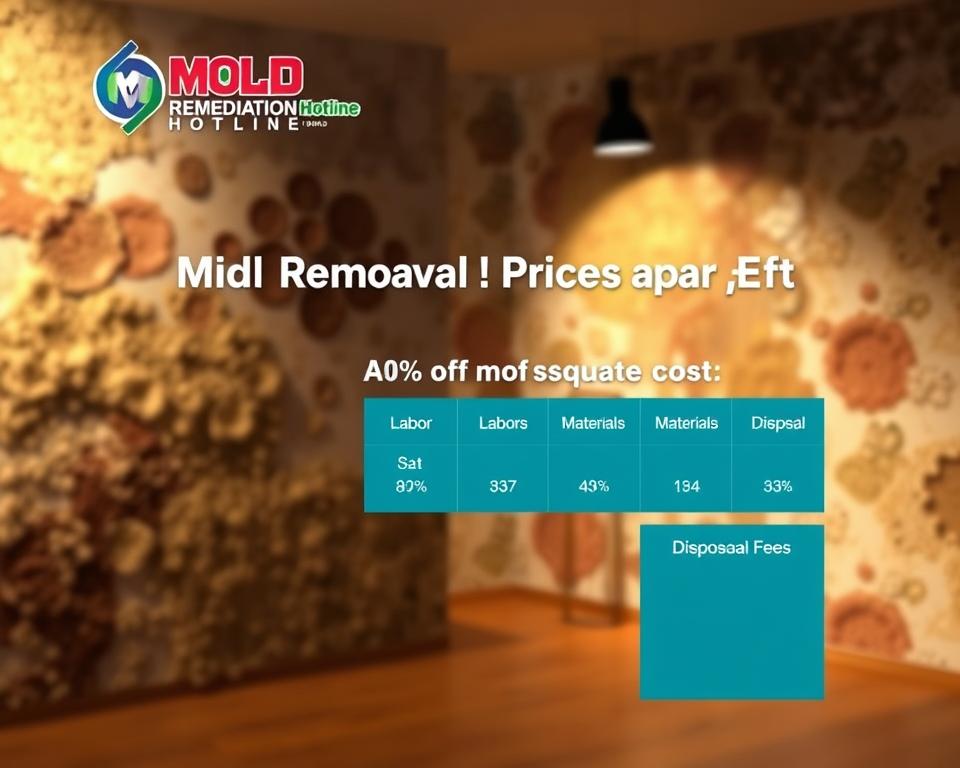Did you know the price to eliminate harmful spores in your home could vary by thousands of dollars? Understanding pricing structures for professional cleanup services isn’t just about numbers—it’s about protecting your health and property value. Homeowners often face quotes ranging from $1,500 to over $30,000, with location, contamination severity, and affected space size driving these differences.
Specialized services typically charge based on square footage, but hidden variables like wall cavities or HVAC system involvement can escalate expenses. For example, remediation in a 1,000-square-foot area might cost $3,500-$15,000, while smaller zones could start at $500. Obtaining multiple assessments ensures transparency and helps avoid overpayment.
This guide breaks down how material porosity, spore type (like black mold vs. common varieties), and containment protocols impact budgets. We’ve analyzed industry data and expert insights to help you make informed decisions without compromising safety.
Key Takeaways
- Cleanup expenses fluctuate based on contamination severity and property location.
- Average professional service fees range from $1,500 to $30,000 nationally.
- Always request at least three detailed estimates before hiring a contractor.
- Square-foot pricing models simplify comparisons but may exclude hidden costs.
- Specialized treatments for toxic spore types increase project budgets.
- Preventive measures reduce long-term remediation needs and costs.
Overview of Mold Remediation and Costs
Mold infestations can silently compromise both your home’s structure and your family’s health. Professional remediation addresses these risks through a systematic process that restores safe living conditions.
What Is Mold Remediation?
This specialized service involves four key steps: identifying contaminated areas, isolating spores to prevent spread, removing affected materials, and cleaning surfaces. Proper execution ensures long-term indoor air quality and minimizes respiratory issues linked to prolonged exposure.
Common indicators include discolored walls, persistent earthy smells, or allergy flare-ups. Excess moisture from burst pipes, roof leaks, or high humidity often accelerates fungal colonization, requiring swift action to limit damage.
General Cost Trends and Ranges
National averages for professional services range from $1,500 to $30,000, with most households spending $3–$7 per area unit. Costs reflect contamination scope, regional labor rates, and material replacements.
| Project Size | Affected Space | Average Cost |
|---|---|---|
| Small | Bathrooms, window sills | $500–$3,000 |
| Medium | Basements, attics | $3,000–$10,000 |
| Large | Whole-house systems | $10,000–$30,000+ |
Later sections explore how spore types, structural complexity, and regional pricing further influence budgets. Always verify contractor credentials and request itemized bids to avoid surprises.
Why Mold Removal Price Comparison Matters
Homeowners often overlook hidden fees in fungal cleanup until invoices arrive. Gathering multiple quotes reveals patterns in service quality and expense structures, acting as financial safeguards against subpar work. Without this step, families risk paying 20-50% more than regional averages for contamination control.
Per-square pricing models simplify budgeting but require scrutiny. One provider might charge $3.50 per area unit for surface treatments, while another includes air duct sanitization in a $5 rate. These differences determine whether you’re funding shortcuts or comprehensive solutions.
Complex projects involving wall cavities or HVAC systems often escalate expenses unexpectedly. A bathroom cleanup quoted at $1,200 could triple if spores penetrate subflooring. Detailed assessments prevent such surprises by clarifying what’s included in each estimate.
Reputable companies combine fair rates with certifications like IICRC or AMRT. Cross-referencing online reviews with licensing databases separates trustworthy specialists from contractors cutting corners. As one industry report states: “Transparent bids correlate strongly with adherence to safety protocols.”
Investing time in comparisons protects both your wallet and indoor air quality. It ensures you’re not overpaying for basic services or underestimating critical containment measures needed for stubborn growths.
Key Factors Affecting Mold Removal Costs
Multiple unseen elements dictate whether your fungal issue becomes a budget nightmare or manageable project. Three primary variables shape remediation costs: where growth occurs, biological characteristics, and workforce demands.
Site Challenges and Structural Access
Contamination in attics or crawl spaces often requires scaffolding or protective gear, adding 15-40% to baseline fees. Bathrooms typically cost less due to smaller areas and non-porous surfaces. However, basements with water-damaged drywall may need structural repairs beyond standard cleanup.
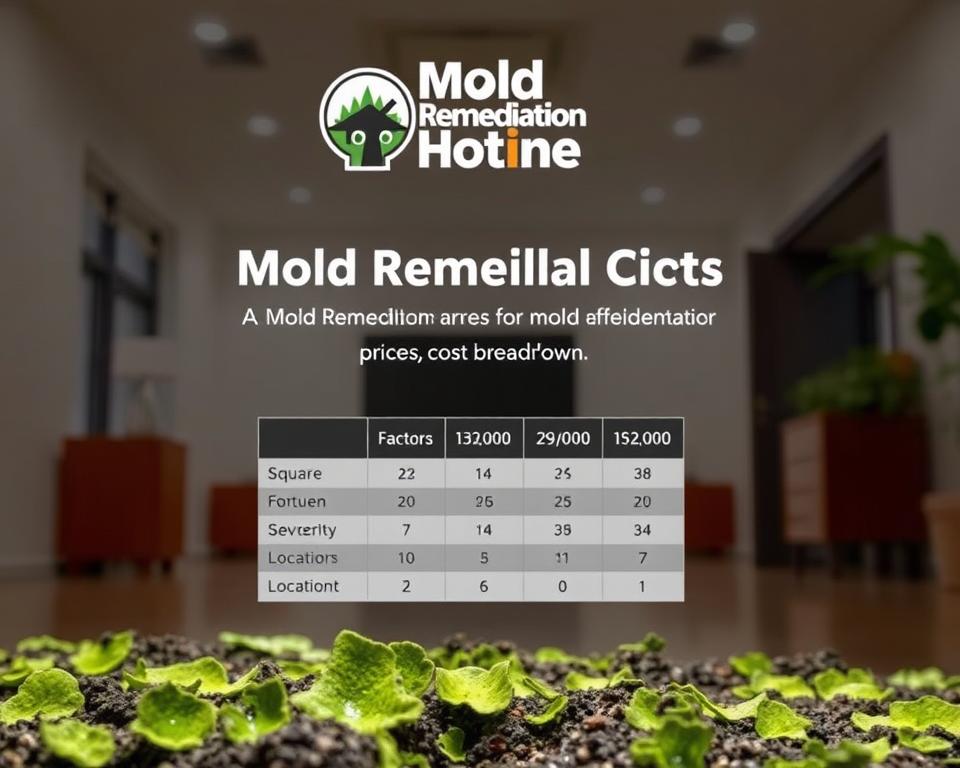
Biological Complexity and Workforce Needs
Stachybotrys (black mold) demands hazardous material protocols, while common cladosporium requires less intensive methods. Labor accounts for 60-75% of total expenses, as certified technicians use advanced tools like HEPA vacuums and infrared cameras.
| Project Complexity | Type | Average Cost |
|---|---|---|
| Basic | Surface-level (bathrooms) | $500–$2,000 |
| Moderate | Wall cavities (basements) | $2,500–$7,000 |
| High-risk | Toxic varieties (HVAC systems) | $8,000–$15,000+ |
Early detection through air quality tests can prevent mold from spreading to hidden areas. Fixing leaks within 48 hours reduces regrowth risks by 80%, according to EPA guidelines. Proper ventilation maintenance slashes long-term remediation costs by addressing moisture sources proactively.
compare mold removal prices per square foot
Square footage isn’t just about space—it’s a key factor in cleanup expenses. Professionals typically charge $10–$30 per affected area unit, with rates reflecting contamination severity and containment needs. This model helps homeowners gauge budgets while ensuring thorough spore elimination.
DIY methods might seem cost-effective at $1–$5 per unit, but they often miss hidden growth. Certified teams use infrared scanners and air quality tests to identify risks behind walls or under floors. One study found 68% of self-treated cases required professional mold services within six months due to incomplete eradication.
Black mold infestations illustrate why expertise matters. Remediation costs jump to $15–$30 per unit for toxic varieties requiring HEPA filtration and protective gear. Compare these scenarios:
| Project Type | Average Cost/SF | Scope |
|---|---|---|
| Surface Cleaning | $10–$15 | Visible growth on non-porous materials |
| Wall Cavity | $18–$25 | Spores in insulation or drywall |
| Toxic Variants | $25–$30+ | HVAC systems or structural beams |
Square-foot pricing simplifies comparisons but verify what’s included. Some contractors bundle air scrubbing, while others charge extra for disposal permits. As EPA guidelines note: “Incomplete containment often leads to recurring biological hazards.”
Licensed services remain essential for complex cases—especially when dealing with respiratory risks or insurance claims. Their structured approach prevents cross-contamination and future remediation costs, making initial investments pay off long-term.
Cost Breakdown by Affected Area
Where fungal growth appears in your home dramatically influences cleanup expenses. Attics, basements, and bathrooms each present unique challenges that shape service fees. Accessibility and material types further determine whether costs stay manageable or spiral.
Attics, Basements, and Bathrooms
Attic projects average $2,000–$6,000 due to cramped spaces and insulation replacement needs. Technicians face ventilation challenges while containing mold spores near roofing materials. Basements often require extensive work ($3,500–$12,000) when water damage affects concrete or wooden supports.
Bathroom jobs typically cost $800–$3,000. Non-porous tiles simplify cleaning, but hidden leaks behind showers may double expenses. Industry data shows 40% of bathroom cases involve subfloor contamination.
Structural and System Complexities
Drywall removal adds $15–$25 per panel, while HVAC system decontamination ranges from $1,500–$5,000. Air ducts spread spores rapidly, requiring specialized vacuum equipment. Whole-house scenarios exceeding 2,000 square feet can reach $30,000 when multiple affected areas require treatment.
| Area | Challenges | Cost Range |
|---|---|---|
| Attic | Insulation replacement | $2,000–$6,000 |
| Basement | Structural repairs | $3,500–$12,000 |
| HVAC Systems | Duct sanitization | $1,500–$5,000 |
Homeowners should request area-specific estimates. Contractors might charge 20% more for hard-to-reach spaces like crawl spaces. Early identification in one affected area prevents costly spread to other zones.
DIY Versus Professional Mold Remediation
Home improvement projects often tempt homeowners to handle biological hazards themselves. While small surface growth might seem manageable, improper techniques can escalate health risks and repair bills.
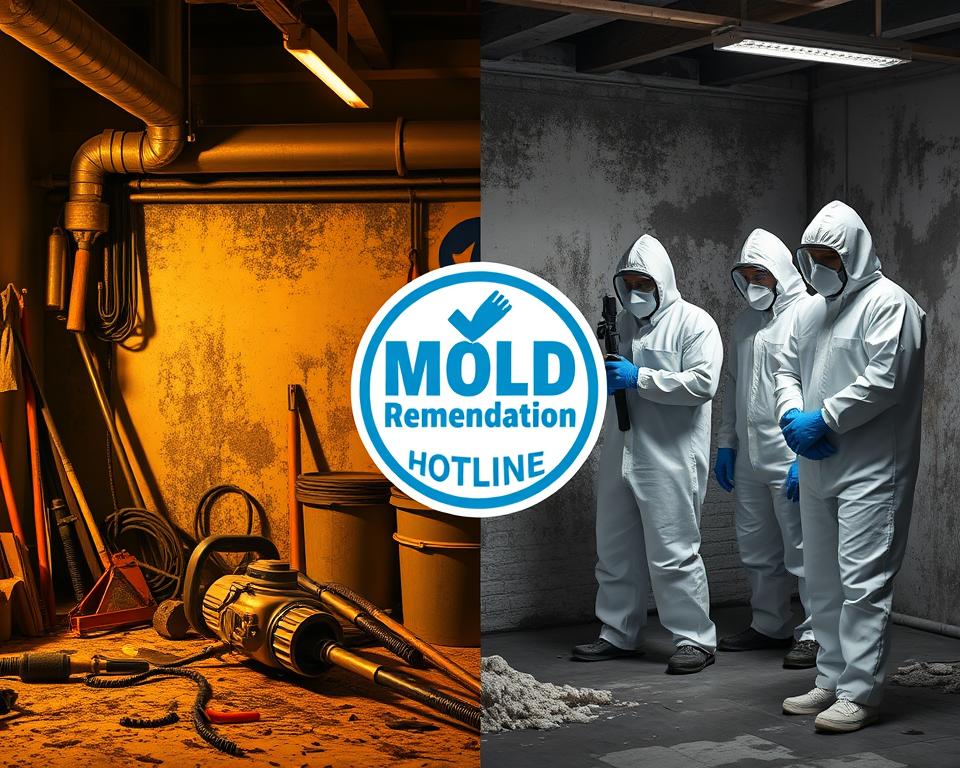
Homeowner-Driven Cleanup Considerations
Basic bathroom tile scrubbing with vinegar costs under $50. This works for visible patches smaller than 10 square feet. However, 73% of DIY attempts fail to address root moisture sources, according to indoor air quality studies.
- Pros: Immediate action, lower upfront costs, personal control
- Cons: Incomplete spore removal, missed hidden growth, exposure risks
Critical Scenarios Requiring Expertise
Certified teams become essential when contamination spans multiple rooms or involves ventilation systems. Their industrial-grade equipment detects 89% more hidden growth than consumer tools, per EPA reports.
| Factor | DIY Approach | Professional Service |
|---|---|---|
| Safety Gear | Basic masks | Full respirators & suits |
| Containment | Plastic sheeting | Negative air chambers |
| Success Rate | 32% | 98% |
Structural damage from water leaks often requires specialized drying equipment homeowners lack. Licensed technicians follow IICRC standards to prevent cross-contamination—a process DIY kits can’t replicate. As one industrial hygienist notes: “What you save today might cost triple in medical bills tomorrow.”
Mold Remediation Pricing Examples and Ranges
A bathroom spot treatment might cost less than a car repair, while whole-home projects rival renovation budgets. Service fees depend on three critical elements: contamination size, material replacements, and safety protocols required for different spore types.
Small-Scale Versus Large-Scale Infestations
A 100-square-foot bathroom cleanup typically runs $800–$2,500. This covers surface scrubbing, moisture control, and minor drywall repairs. In contrast, 2,000-square-foot whole-home scenarios often exceed $25,000 due to HVAC sanitization and structural drying.
Industry breakdowns reveal distinct patterns:
| Scope | Common Locations | Price Range |
|---|---|---|
| Minor | Window sills, shower tiles | $500–$1,200 |
| Moderate | Basement walls, attic insulation | $4,000–$8,000 |
| Severe | Entire floors, air ducts | $15,000–$30,000+ |
Labor accounts for 60-70% of total cost in complex cases. Hazardous varieties like stachybotrys require $12–$18 more per hour for certified technicians. Material disposal fees add $200–$1,500 depending on local regulations.
Always obtain three detailed quotes. One provider might charge $3,800 for attic work while another includes air quality testing in a $4,500 package. As noted in recent industry surveys: “Transparent bids reduce financial stress by 43% compared to single estimates.”
Understanding Mold Removal Materials and Labor Costs
Breaking down biological hazard elimination budgets reveals two core components: specialized materials and skilled labor. Industry data shows workforce expenses consume 60% of total project funds, while equipment and chemicals account for 40%.
Essential Supplies and Technical Gear
Certified teams use antimicrobial sprays ($25–$50/gallon), HEPA air scrubbers ($200–$500/day), and containment barriers ($0.50–$2/sq ft). Hazardous varieties like stachybotrys require pricier EPA-registered biocides. Material costs jump 30–50% when replacing drywall or insulation in affected areas.
| Material Type | Average Cost | Usage Scope |
|---|---|---|
| Antimicrobial Cleaners | $80–$150 | Surface treatment |
| Protective Gear | $100–$300 | Full-body suits |
| Air Filtration | $400–$800 | 500–1,000 sq ft |
Workforce Expertise and Time Investments
Labor rates range from $45–$150/hour based on certifications. A 500-square-foot basement project might require 18–25 hours for:
- Containment setup (3–5 hours)
- Material removal (6–8 hours)
- Air quality testing (2–4 hours)
Complex HVAC system cleanups demand technicians with AMRT certifications, adding 20–35% to workforce expenses. One industrial hygienist notes: “Proper safety protocols extend project timelines but prevent costly recontamination.”
| Project Size | Labor Hours | Total Labor Cost |
|---|---|---|
| Small (100 sq ft) | 8–12 | $600–$1,800 |
| Medium (500 sq ft) | 20–30 | $1,500–$4,500 |
| Large (2,000+ sq ft) | 75–120 | $6,000–$18,000 |
Always review bids for material/labor splits. Some contractors bundle equipment rentals, while others list them separately. This clarity helps homeowners assess value beyond the bottom-line quote.
Regional Variations in Mold Removal Costs
Where you live dramatically shapes fungal cleanup expenses. Labor rates, material availability, and local humidity levels create price gaps exceeding 60% between states. Coastal metros often face steeper bills due to stringent safety codes and higher living costs.
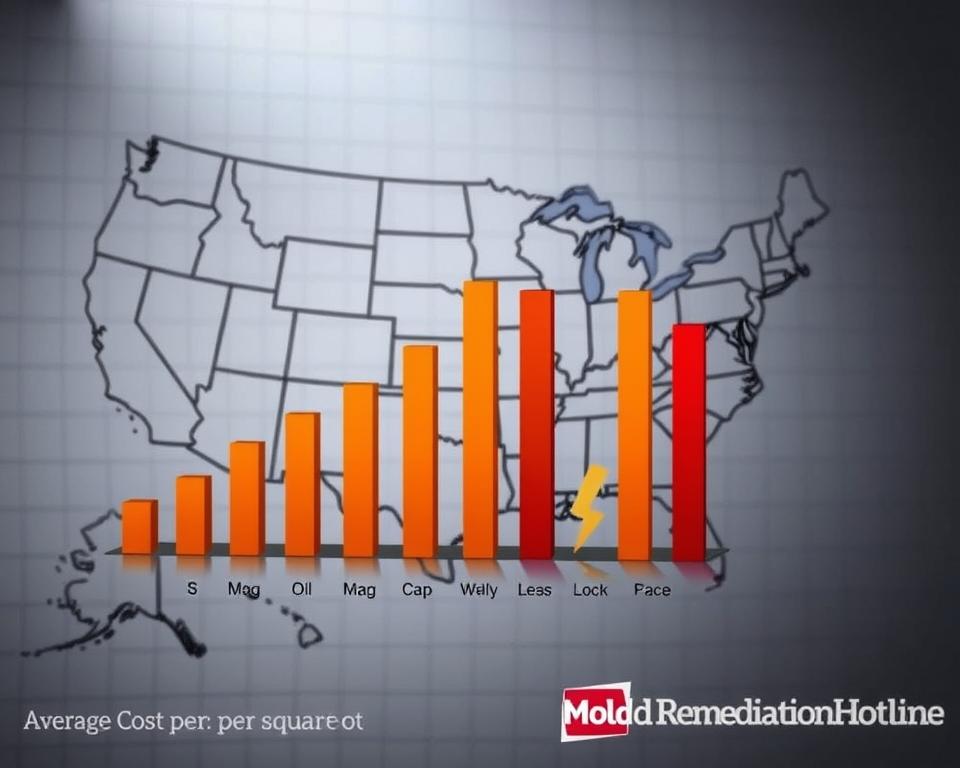
Coastal Premiums vs. Inland Affordability
California and New York contractors charge $18–$35 per area unit—nearly double Midwest rates. Strict containment rules in earthquake-prone zones add 22–40% to project totals. Southern states like Florida see mid-range fees ($12–$25) despite high humidity, thanks to competitive markets.
| Region | Cost Range | Key Influencers |
|---|---|---|
| West Coast | $8–$18/sf | Seismic retrofitting needs |
| Midwest | $5–$12/sf | Lower permit fees |
| Gulf States | $7–$15/sf | Flood-related water damage |
Desert areas like Arizona counterbalance dry air with costly water damage repairs from AC overuse. One Phoenix contractor notes: “Evaporative coolers breed spores if not maintained monthly.”
Homeowners should request location-adjusted estimates. Urban centers often have 15–20% higher rates than rural areas for identical services. Checking state licensing boards helps identify fair regional pricing benchmarks.
Impact of Hidden Mold and Structural Damage
Unseen biological growths pose greater threats than visible patches, often remaining undetected until significant harm occurs. These concealed colonies thrive behind walls, under floors, or within ventilation systems, silently degrading building components.
Assessing Risks in Concealed Spaces
Hidden biological contamination typically involves three elements: inaccessible locations, compromised materials, and delayed discovery. Drywall and insulation absorb moisture, creating ideal breeding grounds that weaken structural integrity over time.
Air ducts spread spores throughout properties, accelerating damage to multiple areas. Left unchecked, this can lead to:
- Wood rot in load-bearing beams
- Corrosion of metal fixtures
- Complete drywall replacement needs
| Location | Required Actions | Average Cost |
|---|---|---|
| Wall Cavities | Demolition & insulation replacement | $2,800–$6,500 |
| HVAC Ducts | System sanitization & filter upgrades | $1,900–$4,200 |
| Subflooring | Joist repairs & vapor barriers | $4,500–$11,000 |
Infrared cameras and moisture meters help professionals identify problems early. As noted in EPA documentation: “Approximately 30% of structural compromises stem from undetected biological growth.”
Timely inspections prevent catastrophic damage by addressing issues before they require full material replacements. Certified technicians follow IICRC standards to contain spores during demolition, protecting unaffected areas from cross-contamination.
Preventive Measures to Reduce Mold Growth
Could controlling your home’s moisture levels slash future repair bills by 75%? Proactive strategies stop fungal issues before they start, protecting both health and property. Experts emphasize addressing water intrusion within 24-48 hours to avoid costly biological hazards.
Humidity Control and Leak Management
Maintain indoor humidity between 30-50% using hygrometers and dehumidifiers. Bathrooms and kitchens benefit from exhaust fans running 20 minutes post-shower or cooking. Fix dripping faucets immediately—even minor leaks create ideal conditions for microbial activity.
Regular roof inspections and gutter cleaning prevent water accumulation near foundations. Consider these essential tasks:
- Replace cracked caulking around windows annually
- Grade soil away from building exteriors
- Insulate pipes to prevent condensation
| Preventive Action | Impact | Cost Range |
|---|---|---|
| Dehumidifier Installation | Reduces humidity 40-60% | $200-$1,500 |
| Ventilation Upgrades | Cuts moisture retention 70% | $300-$2,000 |
| Foundation Sealing | Prevents water intrusion | $1,000-$5,000 |
Proper insulation in attics and crawl spaces regulates temperature differentials that cause condensation. EPA studies show homes with vapor barriers experience 55% fewer wall cavity issues. “Moisture management isn’t optional—it’s structural insurance,” notes building scientist Dr. Elena Torres.
Monitor problem areas like basements weekly during rainy seasons. Early intervention prevents minor dampness from escalating into major growth challenges. These measures safeguard indoor air quality while avoiding expensive remediation projects.
Maintenance Tips for Preventing Mold Regrowth
Keeping your home free from biological hazards requires ongoing vigilance. Simple routines and strategic upgrades create environments where spores struggle to thrive, protecting both your investment and well-being.
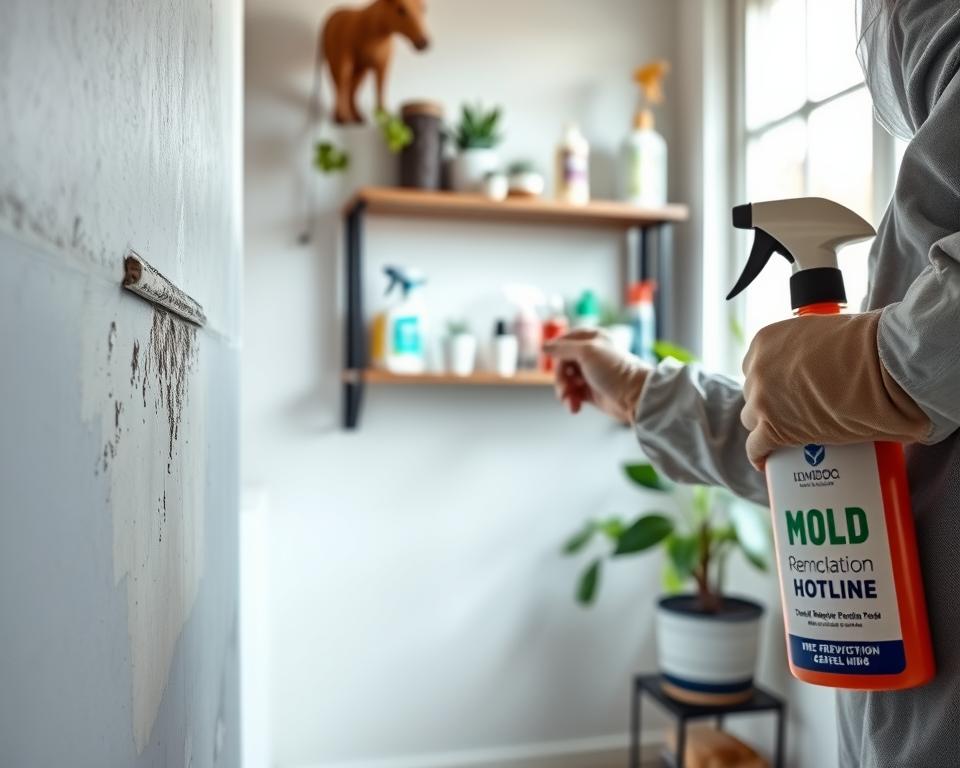
Regular Inspections and Ventilation Strategies
Conduct monthly checks in moisture-prone zones like basements and attics. Use a flashlight to examine corners, pipes, and drywall seams for discoloration or dampness. Bathrooms and laundry rooms need weekly attention—wipe down surfaces after use to eliminate condensation.
Boost airflow with these tactics:
- Run exhaust fans during showers and 20 minutes afterward
- Open windows crosswise to create natural drafts
- Install vented soffits in attic eaves
Dehumidifiers maintain optimal 30-50% humidity levels. Pair them with hygrometers ($10-$25) to monitor problem areas. For homes with crawl spaces, vapor barriers ($0.50-$1.50 per square foot) block ground moisture effectively.
Schedule professional assessments every 12-18 months. Certified inspectors use thermal imaging to spot hidden risks, often identifying issues 83% faster than untrained eyes. As building biologist Mark Harris advises: “Prevention beats remediation—both in cost and stress.”
Use mold-resistant paints in high-humidity zones and replace caulking annually. For cleaning, hydrogen peroxide solutions (3% concentration) safely disinfect non-porous surfaces without harsh fumes. These proactive steps form a defense system against recurring biological threats.
Insurance and Financial Considerations
Navigating insurance policies for biological hazard cleanup feels like deciphering legal code. Most standard homeowners’ plans exclude microbial growth unless it stems from sudden, covered disasters like burst pipes or hurricane flooding. Slow leaks from humidity issues or neglected maintenance? Those repair bills likely land squarely on your budget.
Understanding Homeowners Insurance Coverage
Insurers typically approve claims only when contamination directly results from:
- Storm-related water intrusion
- Appliance malfunctions (e.g., water heater rupture)
- Fire suppression efforts
HVAC system decontamination often requires separate riders. A 2023 industry study found 78% of policies deny ductwork sanitization unless part of a fire/water damage claim. Prepare for $1,200–$5,000 out-of-pocket costs for air quality upgrades.
| Claim Scenario | Coverage Likelihood | Average Payout |
|---|---|---|
| Flood-induced growth | High (with flood insurance) | $8,000–$15,000 |
| Chronic bathroom leaks | Low | $0–$500 |
| Storm-damaged roof | Moderate | $3,000–$10,000 |
Property size impacts deductibles and coverage caps. A 500-square-foot attic project might max out a $10,000 policy limit, while smaller areas could fall below your deductible. Always request written clarification from agents—verbal assurances hold no weight during disputes.
Supplemental riders costing $200–$600 annually expand protection for humidity-prone regions. As risk advisor Tara Simmons notes: “Assume exclusion until proven otherwise. Documentation wins claims.”
Tips for Comparing Estimates from Mold Remediation Companies
Selecting the right contractor requires more than just price checks—it demands strategic evaluation of expertise and service scope. Three critical factors separate reliable providers from those cutting corners: transparency in processes, validation of credentials, and alignment with industry standards.
Key Questions to Ask Providers
Start by requesting proof of IICRC or ACAC certifications—non-negotiable markers of technical proficiency. Ask: “What containment systems will you use to prevent cross-contamination?” Reputable teams outline steps like negative air pressure setups and HEPA filtration deployment.
Clarify insurance coverage details. A $2 million general liability policy should cover property damage risks. Demand itemized breakdowns showing labor rates, material costs, and post-cleanup testing fees. Hidden charges often lurk in disposal permits or antimicrobial spray applications.
Evaluating Certifications and Experience
Prioritize companies with 5+ years addressing your specific issues, whether HVAC system sanitization or drywall replacement. Check online reviews for mentions of:
- Adherence to projected timelines
- Communication during the process
- Post-remediation air quality results
Providers quoting substantially below market rates often skip vital steps like moisture mapping. As industry veteran Lila Torres warns: “Lowball bids usually mean high-risk shortcuts.”
Request references for past projects matching your home’s size and contamination type. Cross-verify licensing through state databases—active status confirms compliance with evolving safety protocols. This due diligence ensures your investment eliminates biological hazards effectively.
Conclusion
Managing fungal contamination costs requires balancing health priorities with financial realities. Your location, affected space size, and spore type all shape service fees—but informed choices prevent overspending while ensuring safe environments.
Professional assessments prove critical when dealing with hidden growth or toxic varieties. DIY methods often miss root causes like structural leaks, leading to recurring issues. Certified teams address moisture sources and containment protocols that protect long-term air quality.
Preventive maintenance remains your strongest defense. Simple actions like humidity control and prompt pipe repairs reduce recontamination risks by 62%, according to EPA data. Regular inspections catch problems early, minimizing future remediation needs.
Homeowners should prioritize detailed estimates from licensed providers. Compare service inclusions—not just bottom-line figures—to gauge true value. This approach safeguards both your budget and family’s health while maintaining property integrity.
Take action today: Request three localized quotes that account for your unique situation. Knowledge transforms complex challenges into manageable solutions.
